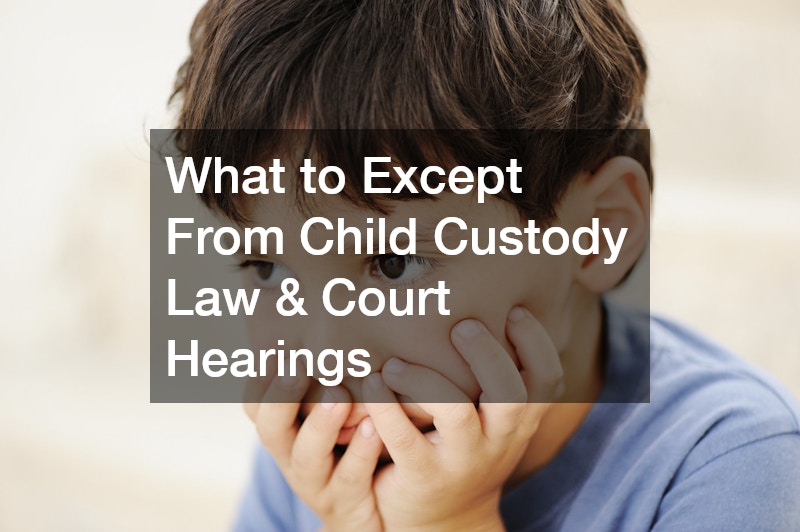What to Except From Child Custody Law and Court Hearings

Navigate the complexities of child custody law and court hearings with a comprehensive overview of what to expect. Understanding the basic elements is crucial for achieving the best possible outcome.
1. What Determines Child Custody Decisions?
A) Factors Considered by the Court
In child custody proceedings, the paramount concern of the court is the best interests of the child. This overarching principle necessitates a comprehensive evaluation of numerous factors to ensure the child’s holistic well-being.
The court meticulously assesses the child’s physical, emotional, and educational needs, striving to place the child in an environment that best caters to these aspects.
Parental capabilities are a critical component of the court’s assessment. This involves examining each parent’s capacity to provide consistent care, nurturing, and guidance. The court may consider factors such as the parents’ mental and physical health, their financial stability, and their ability to cooperate in matters concerning the child. Furthermore, the stability that each parent can offer is carefully weighed. This includes evaluating the consistency of their living arrangements, their support systems, and their ability to provide a predictable and secure environment for the child’s upbringing.
The emotional bonds and attachments between the child and each parent are also significant considerations. The court recognizes the importance of maintaining and fostering healthy relationships between the child and both parents, where appropriate. Testimony from the child, if deemed mature enough, as well as observations from professionals, may be considered in understanding these emotional connections.
A history of domestic violence perpetrated by either parent is subject to particularly rigorous scrutiny. The court prioritizes the safety and welfare of the child above all else, and any evidence of domestic violence raises serious concerns about the potential for harm. Investigations into such allegations are thorough, and the court will take decisive action to protect the child from any risk of abuse or neglect. This may involve limiting or even terminating a parent’s custodial rights.
B) Different Types of Custody Arrangements
Physical custody determines where the child will primarily reside and who will be responsible for daily care. Legal custody involves the right to make significant decisions affecting the child’s life, such as education and healthcare choices.
Sole custody grants one parent all rights and responsibilities, often used in cases where one parent is deemed unfit due to factors like substance abuse or neglect. Joint custody, however, allows both parents to share both physical and legal responsibilities equitably.
Real-world scenarios often illustrate the intricate balance required in custody arrangements. For instance, joint legal custody might still be feasible even if one parent has more physical custody time due to geographical considerations.
2. How to Prepare for a Child Custody Hearing?
A) Gathering Necessary Documents and Evidence
Preparation for a child custody hearing starts with gathering essential documents that evidence your role in the child’s life. This includes financial records, which can demonstrate your ability to provide for the child’s needs.
Including character references from teachers or community leaders can also bolster your case by highlighting your parenting capabilities. Maintaining thorough communication logs with the other parent is crucial in illustrating cooperation or possible communication breakdowns.
Presenting organized and relevant documentation shows the court your commitment to your child’s welfare. Such evidence provides a comprehensive view of your involvement and ability to meet your child’s needs effectively.
B) Legal Representation and Courtroom Etiquette
Securing skilled legal representation can significantly impact the outcome of a custody hearing. Experienced attorneys guide you through the complexities of the legal process and help present your case effectively.
Courtroom etiquette is paramount and involves maintaining a respectful and calm demeanor. Presenting yourself professionally influences how the judge perceives your character and commitment as a parent.
Attorneys often prepare their clients with potential questions and courtroom scenarios. Knowing what to expect helps reinforce your case and builds confidence during the hearing.
3. What Can You Expect During and After the Court Hearing?
A) Courtroom Procedures and Timeline
A child custody hearing typically begins with opening statements, where each side outlines their case. Evidence is presented next, including witness testimonies and documentary evidence, supporting each parent’s position.
Following the evidence presentation, closing remarks summarize the primary arguments and reiterate key facts. The timeline for these proceedings can vary depending on the complexity of the case and court scheduling.
Understanding the procedural timeline offers clarity and helps you set realistic expectations. It also enables you to manage the emotional aspects of the process better by knowing what each stage entails.
B) Post-Hearing Outcomes and Compliance
After the hearing, the court issues an order detailing custody arrangements and responsibilities for each parent. Compliance with the court’s directives is legally binding, and any violation can lead to legal consequences.
If the other parent fails to comply with the court order, legal remedies are available. This can include filing a contempt motion, which can enforce adherence to the established agreement.
The outcomes of a custody hearing have a profound impact on the family dynamic. Consistently prioritizing the child’s welfare ensures smoother transitions and helps stabilize the family structure post-hearing.
Child custody law can be daunting, but understanding the key elements and preparing thoroughly can aid in navigating court hearings successfully. Always prioritize the well-being of your child while working towards a favorable conclusion.
.



